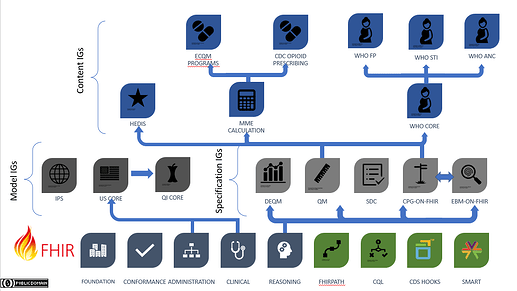Dear OHIE Community,
In conversation with @bryn, we recently learned 2 important concepts:
- There are multiple TYPES of FHIR IGs (Implementation Guides).
- Content FHIR IGs are not the same as Model FHIR IGs.
There’s Currently Confusion about FHIR IGs in the Global Good & OHIE Communities
I notice across Global Goods we seem to be confusing one another when we just talk about “a FHIR IG” without clarifying the type of IG that we mean.
For example: I’ve had numerous conversations this year with other Global Good technicians saying “We are ready to integrate with OpenMRS because we have a FHIR IG” (they were not actually ready with the right type); or, where others have said to me “We don’t see how a FHIR IG will help our Global Goods be interoperable; a FHIR IG is only content guidance… right?” (Not necessarily! ![]() )
)
The Main Point: Global Good Integration through FHIR typically relies on one or more “Model IGs”, whereas the WHO’s SMART Guidelines L3 FHIR approach uses “Content IGs”.
The 2 Major Types of FHIR IGs You Should Know:
It’s really the first 2 that we should be aware of:
- Model IGs: These are like “Connect the Dots” toolkits, explaining “Here is how our system or standard uses FHIR.” For example, the International Patient Summary says “This is how a Patient Summary puts together immunization, medication and procedure history”. Even more specifically, the OpenMRS Model FHIR IG says “This is how our system’s data model converts our patient information into a FHIR patient resource”.
Examples:
- OpenMRS Model FHIR IG: https://fhir.openmrs.org/
- OpenELIS Model FHIR IG: https://i-tech-uw.github.io/openelis-global2-fhir-ig/
- OpenIMIS Model FHIR IG: https://fhir.openimis.org/
(I’m not aware of other Global Goods’ Model FHIR IGs but would love to know!)
Model IGs are quite powerful for in-country implementation teams who need to connect multiple Global Goods, and want to avoid the headache and overhead of having to learn and map the data models between Global Good A, B, and C. For example, UW ITECH found that once they had enough use-case coverage between the OpenMRS Model IG and the OpenELIS FHIR IG, the time for their team to set up integration between OpenMRS and OpenELIS went from 3-6 months to just ~2 days. Video demo of this here.
- Content IGs: Like a FHIR-ized Clinical Practice Guideline. These are effectively “Content Toolkits” that focus specifically on the content you would need in a particular use case or domain (e.g. ANC, HIV, etc), and then uses FHIR’s structure to organize that content. For example, medical terminology/codes/concepts are organized under a “valueSet” directory; whereas decision support rules and business logic are organized under the “planDefinitions” area.
- Content IG Examples: The WHO SMART Guidelines L3 FHIR IGs (like this ANC one) are a great example! Or the CDC Opioid Rx IG.
Other IGs: There are other possible types of FHIR IGs, such as Specification IGs. These tell people what patterns to follow when they want to write detailed clinical guidance using the FHIR structure. Maybe not many of us will directly write a Specification IG ourselves, but we may use one to create a Content IG. For example, the Clinical Practice Guidelines IG has informed how subsequent Content IGs were written by the WHO SMART L3 Authoring team.
For More Information
More detailed examples (and this visual with more examples) available on the FHIR website here: Clinicalreasoning-knowledge-artifact-distribution - FHIR v6.0.0-cibuild
CC @costateixeira & @jennifer.e.shivers & @jthompson & @carl would love your help disseminating this important difference ![]()
And a big thank-you to @costateixeira, @caseynth, and @pmankow for reviewing this post for accuracy in advance ![]()
